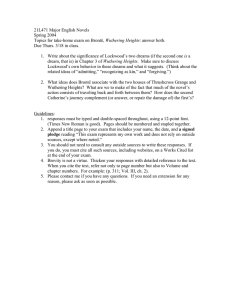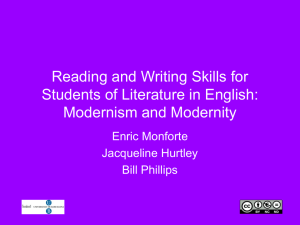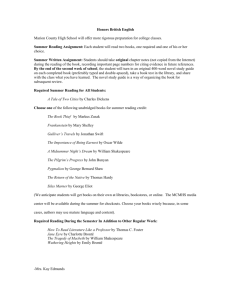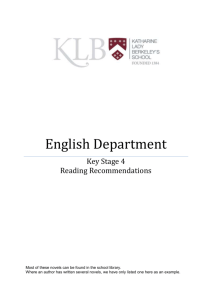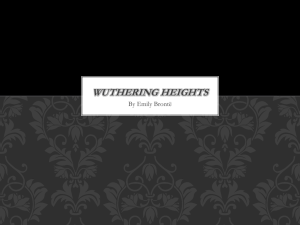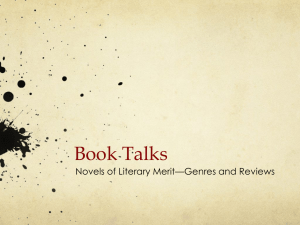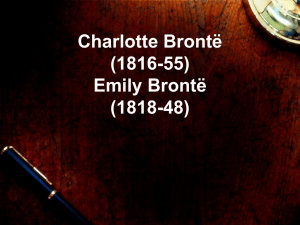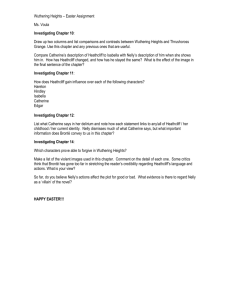Paula Alexandra Varanda Ribeiro Guimarães Emily Brontë’s Musical Appropriations:
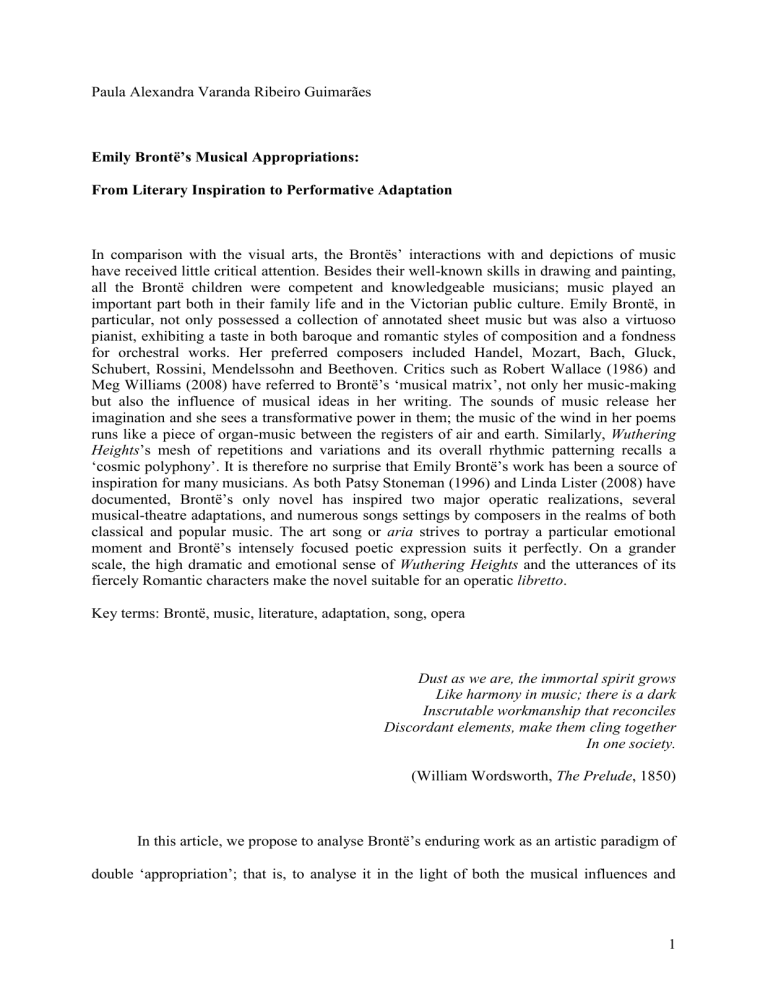
Paula Alexandra Varanda Ribeiro Guimarães
Emily Brontë’s Musical Appropriations:
From Literary Inspiration to Performative Adaptation
In comparison with the visual arts, the Brontës’ interactions with and depictions of music have received little critical attention. Besides their well-known skills in drawing and painting, all the Brontë children were competent and knowledgeable musicians; music played an important part both in their family life and in the Victorian public culture. Emily Brontë, in particular, not only possessed a collection of annotated sheet music but was also a virtuoso pianist, exhibiting a taste in both baroque and romantic styles of composition and a fondness for orchestral works. Her preferred composers included Handel, Mozart, Bach, Gluck,
Schubert, Rossini, Mendelssohn and Beethoven. Critics such as Robert Wallace (1986) and
Meg Williams (2008) have referred to Brontë’s ‘musical matrix’, not only her music-making but also the influence of musical ideas in her writing. The sounds of music release her imagination and she sees a transformative power in them; the music of the wind in her poems runs like a piece of organ-music between the registers of air and earth. Similarly, Wuthering
Heights
’s mesh of repetitions and variations and its overall rhythmic patterning recalls a
‘cosmic polyphony’. It is therefore no surprise that Emily Brontë’s work has been a source of inspiration for many musicians. As both Patsy Stoneman (1996) and Linda Lister (2008) have documented, Brontë’s only novel has inspired two major operatic realizations, several musical-theatre adaptations, and numerous songs settings by composers in the realms of both classical and popular music. The art song or aria strives to portray a particular emotional moment and Brontë’s intensely focused poetic expression suits it perfectly. On a grander scale, the high dramatic and emotional sense of Wuthering Heights and the utterances of its fiercely Romantic characters make the novel suitable for an operatic libretto .
Key terms: Brontë, music, literature, adaptation, song, opera
Dust as we are, the immortal spirit grows
Like harmony in music; there is a dark
Inscrutable workmanship that reconciles
Discordant elements, make them cling together
In one society.
(William Wordsworth, The Prelude , 1850)
In this article, we propose to analyse Brontë’s enduring work as an artistic paradigm of double ‘appropriation’; that is, to analyse it in the light of both the musical influences and
1
practices (ideas and techniques) present in her poetry and only novel, and the multifaceted influence of her literary texts on modern musical artists (composers and performers), evident in the multiple adaptations to opera, musical drama, art song cycle, pop song and movie soundtrack. We hope that in the course of our exposition, the intertextual/interartistic relations between literature and music, often designated as ‘melopoetics’ or ‘word and music’ studies, will help further illuminate and enrich our assessment of Emily Brontë’s work.
In the now classic Music and Literature: A Comparison of the Arts , Calvin S. Brown stated that “music and literature are intended to be heard” and that their privileged media of presentation is “the audible”: “literature is an art presented to the ear rather than to the eye” because when we read we mentally hear sounds (1948: 8-9).
1
Organised sound indeed serves as basic material for both arts, though the respective sound units – word and tone – differ substantially. More recently, melopoetics critics Steven Scher and Walter Bernhart have added that in the traditional classification of the fine arts, music and literature “are viewed as closely akin because they both are auditory, temporal, and dynamic art forms” ( Literature and
Music , 1986: 180). They have affinities in structure because both arts require “attentive tracing of a certain movement to be completed in time”, they are “ activities to be realized (a score to be performed or a book to be read), i.e. processes that still need to be decoded”
(Scher, 1986: 180, our emphasis). Furthermore, the organising principles of ‘repetition’ and
‘variation’ are indispensable to both, as well as those of ‘balance’ and ‘contrast’.
2
The interartistic parallels between the two arts can be roughly divided into three main categories: ‘music and literature’, ‘literature in music’, and ‘music in literature’ (Scher and
Bernhart, 1986). In the first category, generally called ‘vocal music’, literary text and musical
1 Charles Avison was the first critic to stress the emotive aspect of music and convincingly challenge the primacy of the traditional mimetic principle in his An Essay on Musical Expression (London, 1752). Hearing has traditionally been seen as the medium of experience, intuition, intensity, and immediacy. It has also been associated, rightly or wrongly, with “everything that predates and even threatens the rational, reflective subject: the oral, the infantile, the archaic, the instinctive, the irrational” (Connor, 1997: 2).
2 These organising principles “pervade both musical and literary textures; and the straightforward way they usually function in the respective arts yields many points of contact for legitimate comparison.” (Scher, 1986: 9).
2
composition are inextricably bound and result in a single work; this combination is visible in forms such as the opera or the art song or lied.
3 The second category, also called ‘programme music’, refers to purely musical works that have been inspired in, or suggested by, a specific and paradigmatic literary text; that may be the case of a symphony, a sonata or a fugue.
4
The third and last category refers exclusively to musical themes or references present in literary texts (‘verbal music’) and acoustic structures or techniques (‘word music’) used by writers, namely in poetry.
5
Although Emily Brontë’s work has notoriously called for a combination of these three different realizations, we will concentrate our analysis mostly on the first and third categories, respectively ‘vocal music’ and ‘word music’, making only cursory remarks on the second one.
6
Ever since 1800, Romantic aesthetics, openly advocating the elimination of boundaries in theory and poetic practice, has had a major impact on the development of the interrelation.
Phyllis Weliver refers not only the ‘Aeolian harp’ as a central image for poetic inspiration but also the Victorian fascination with the figure of the siren, which represents music’s seductive effects ( The Figure of Music , 2005: 11, 22). The trend of comparisons culminated in the nineteenth century in the aesthetics of ‘melomaniac’ Romanticists like Ludwig Tieck,
Novalis, and E. T. A. Hoffman, who proclaimed the supremacy of music among the arts. The musical aesthetic seems to emanate from the land – its winds, waters and birds, transcending material contingency as it transcends language itself (Byerly, 1997: 13). Thus, if the
3 Operatic masterpieces and outstanding examples of the lied have also been created from existing literary works, such as Verdi’s Macbeth and Schubert’s settings of Goethe’s poems. Combinations of text and music in a single work include also a host of other forms familiar from past centuries of European musical and theatrical history, such as oratorios, cantatas, motets, madrigals, a capella choruses, ballads, the English masque and the German singspiel .
4 In this category we might include some of Beethoven’s symphonies and sonatas.
5 Affinity in material, rhythm, stress, pitch and timbre are all applicable in literature, more or less effectively, to create musiclike textures.
6 It is important to clarify that, strictly speaking, these musico-literary phenomena, although obviously interconnected, belong to different disciplines: ‘literature in music’ is usually studied in musicology, ‘music in literature’ is mainly treated in literary studies; the only truly hybrid or double category is ‘music and literature’ because “they constitute a symbiotic construct that qualifies as a full-fledged work of art” (Scher, 1986: 8). For a long time, opera criticism and lied scholarship have been practised almost exclusively by musicologists.
3
musicalization of literature (through ‘word music’ or ‘verbal music’) is a quintessentially
Romantic notion so, in a certain way, is the literalization of music (in the form of ‘programme music’, the lied and the ‘literary opera’).
7
English writer Emily Jane Brontë (1818-1848) was not simply musical , but a serious student of music, in a way that deeply influenced her artistic and literary development. She possessed a considerable collection of annotated sheet music, in both baroque and romantic styles of composition (Williams, 2008: 81), and she became eventually a virtuoso pianist, playing duets with her younger sister Anne. According to biographer Stevie Davies, Brontë’s
German Romantic influences (Schelling, Schlegel, Novalis and Goethe) seem also to have been reinforced by the musical education she received in Belgium around 1842, especially her study of Beethoven ( Heretic , 1994: 51). M. Heger, the Pensionnat ’s headmaster, had arranged piano lessons for her with a renowned teacher from the Brussels Conservatory, and even more significantly, allowed her to teach music to his younger pupils (Williams 81).
Robert K. Wallace, in his 1986 work on
Emily Brontë and Beethoven
, traces the evolution in Brontë’s taste after her visit to Brussels, and eventually concludes that in the
1830s she had played mainly popular themes by lesser-known composers, designed to display virtuoso passagework; but after Brussels she preferred serious and substantial works with the emphasis on instrumental rather than on programme music, showing a distinct preference for transcriptions of Beethoven, Handel, Haydn, Mozart, Bach, Glück, Schubert, Dussek, Weber,
Rossini and Mendelssohn (1986: 160). In Brussels at this time, Beethoven still dominated and she would have had the chance to hear not only his Second Symphony, the Egmont and
Leonora Overtures and the Eroica at the Conservatoire Royal, but also his Seventh
Symphony and a Mendelssohn oratorio at a gala concert (Davies 51).
7 In the form of programme music, one would find Beethoven, Berlioz and Liszt; in the lied genre, the names of
Schubert, Schumann, Brahms and Wolf; and in the literary opera, Wagner’s music dramas.
4
When Emily returned to Haworth in 1843, she bought a new two-pedal, five-and-ahalf octave piano and an eight-volume anthology of piano music, called The Musical Library
(1844), whose markings in the table of contents register the poet’s preference for Beethoven.
As Davies observes, she played transcriptions from the Fourth, Sixth and Seventh
Symphonies, as well as sonatas
; thus, “both the compositional logic and the spiritual passion of Beethoven’s language entered into her own language” (52). Davies agrees with Robert
Wallace’s observations that “In style, texture and vision, her novel has strong affinities with
[Beethoven’s] music”. Davies even uses musical terminology to characterise Brontë’s novel
Wuthering Heights
: “from the appassionata orchestrations of the theme to the pianissimo meditation which carries the reader to the final silence which succeeds ‘that quiet earth’, with its ‘gradual loosening of earthly ties’” (52). And, in fact, Beethoven’s Piano Sonata no. 23 in
F minor Op. 57 of 1807 (known as Apassionata ) is the composer’s most tempestuous sonata, a brilliantly executed display of emotion and music.
Lawrence Kramer suggests that this Beethovian effect results from “a persistent tension between expression and form” (1998: 33). The ‘stormy’ movement seems to be alive with “unresolved formal ambiguity”, giving the musical piece a “symbolic authority” like that of a literary text (35). He detects in Beethoven’s time “three topical fields particularly hospitable to tempests” (41): those of “emotional turmoil, revolutionary violence, and the return of Man to a state of nature” (41). These continually overlap, creating unspoken subtexts. Both
Pathétique
and Apassionata evoke the sort of primitive encounter and tempestuous atmosphere later present in Brontë’s novel.
Charlotte Brontë, in her ‘Biographical Notice of Ellis and Acton Bell’ (1850), had famously defined the originality of Emily’s poetry in terms of its “ peculiar music – wild, melancholy and elevating” (1995: 319, our emphasis), though it was clear that her sister had absorbed the language of poets such as Shakespeare, Milton, Wordsworth and Coleridge. As
5
Meg Williams states, writing about Emily’s ‘musical matrix’, she “hears the music above everything else, puts her trust in it, and follows where it leads” (2008: 82), casting her
“anchor of Desire/ Deep in unknown Eternity” (
Poems , 174).
8
Eternity, Williams reminds us, is the infinite Platonic source of musical ideas, and its messages are brought like soundwaves by the “glorious wind” she so frequently invokes (82). The “spirit’s sky” is a source of
“strange minstrelsy” where “a thousand silvery lyres / Resound far and near” ( Poems 149) and Brontë sees a transforming power in music. For Williams, the inspiring wind is “not a purely natural phenomenon but a container for the voices of all those who form part of her emotional legacy and who help to shape its theme-tunes” (82).
9
Williams traces Wuthering
Heights
’s origins to the very roots of culture and oral/aural traditions and enhances the fact that it is written in dialogue, insisting on “the supremacy of the speaking voice and its volatile rhythm” (2008: 84). The figure of Heathcliff brings “dissonance like a clashing chord” while the narrative seems to “progress through consonance and dissonance, stress and release”, in a
“symphonic crescendo
” (87-88).
In her 2008 essay on operatic and song treatments of Emily Brontë’s texts, entitled in short “Music of the Moors”, Linda Lister (assistant professor of voice and director of the
Opera Workshop at Shorter College), takes into the realm of adaptation the question of the
‘musical’ quality of Emily’s writing. Lister’s approach to the musical portrayals of Catherine
Earnshaw and of Brontë’s poetic speakers is informed by her experience as a vocalist and composer, as well as a musicologist. She analyses the dramatic and musical portrayals of
Catherine in Carlisle Floyd’s and Bernard Herrmann’s respective operatic versions of the novel. But she also comments on Kate Bush’s Wuthering Heightsinspired pop song and
Lister’s own song settings of Brontë’s texts from her novel and poems.
8 Williams will focus on the way Brontë’s musicality relates to the aesthetic evolution of emotionality in the novel, linking this to some psychoanalytic and philosophical ideas about symbol formation.
9 For a more detailed and extensive analysis of the use and function of ‘voice’ in both Emily and Anne Brontë’s poetry see our article entitled “Exchanging voices, questioning voices …: Dissention and Dialogue in the Poetry of Early Victorian Women” (Guimarães, 2009).
6
When looking for poetry to set to music, Lister observes, “composers often look for a text that distils a particular emotional moment, which defines a mood or situation instantly for the reader” (2008: 213). The aria or art song tends precisely to portray a single emotion or event, as well as their different dimensions. With its intense and focused expression and its symmetry, in terms of both structure and sentiment, Brontë’s poetry seems to be particularly suited to song setting. The cantabile or singable quality of the verse reveals, for Davies, “a musical ear attuned to phrasings and cadences of an expressive but restrained reverie”
(Davies, 1998: 44).
10
On a perhaps grander scale, the high dramatic and emotional sense of Wuthering
Heights and the histrionic utterances of its fiercely Romantic characters make the novel suitable for an operatic libretto. It has been seen as “a musician’s novel”, according to Davies, in which Cathy’s speeches “resemble aria in opera earthed in recitative” (Davies 47). Wallace not only likened its stormy expressivo tone to Beethoven’s piano sonatas, like Apassionata and
Pathètique, but also to the composer’s only opera,
Fidelio, or Conjugal Love (1814), in terms of an embodied ideal of undying love and fidelity (1986: 176). For Lister, Wuthering
Heights “lends itself to opera” not only due to its lyrical and tragic plot of lost love, and its long-suffering emotional characters, but also its dramatic death scene (214). To this, she adds the novel’s “setting on the dark, immense, and mysterious Yorkshire moors”, which is in consonance with “opera’s long tradition of grandiose, ostentatious sets that match and magnify the large-scale scope of the musical drama” (214). Lister also refers to the way in which Brontë’s prose monologues and dialogues “translate exceptionally well into operatic settings” (214).
One of these has been Bernard Herrmann’s four-act opera adaptation,
Wuthering
Heights , completed in 1951. This pre-eminent American composer of film music began his
10 Early in 1937, Benjamin Britten composed a setting of lines from Emily Brontë’s poem “A Day Dream” for tenor and strings, which appeared in The Company of Heaven broadcast by BBC. It was the very first vocal that he composed with the voice of Peter Pears in mind.
7
version in 1941 upon the libretto of Lucille Fletcher, which incorporated some of Brontë’s poetry and text directly from the novel.
11
He was mainly attracted to the work’s theme of obsession, a recurrent motive in many of the films on which he collaborated.
12
Herrmann, who was described as ‘brooding and portentous’ like Heathcliff, was also drawn to complex dichotomies of reality/fantasy, attraction/repulsion and obsession/detachment.
[…] the oneness of the characters with their environment, and also the mood and colours of the day attracted Herrmann. […] His evocation of the moors – magnificent, oppressive, and violent – creates a powerful sense of place, enforcing the landscape’s role in Cathy’s and Heathcliff’s lives, even its control of their emotions (Smith, 2002: 112).
Herrmann’s setting of Brontë’s poetry, with its musical meter and sharp imagery, is affecting throughout.
13
More controversial are Herrmann’s changes in Heathcliff, transformed from “an imp of satan” into a misunderstood tragic figure, in arias like “I am the only being whose doom no tongue would ask”. Scored by Alfred Newman, and inspired in William Wyler’s
1939 film adaptation, the opera possesses a symphonic and cinematic nature. Unfortunately,
Herrmann did not live to see it completely performed onstage, which only happened in
Portland (Oregon), in November 1982.
In
Brontë Transformations
(1996), Patsy Stoneman likened its neo-Romantic musical style to those of Wagner, Puccini, Strauss and Sibelius, amongst others (168). As Lister observes, it is a type of vocal writing, “a lyrical parlando
” which “strives for a naturalistic imitation of speech patterns” and which has been compared with Benjamin Britten (2008:
215). But Herrmann’s Cathy becomes a ghostly presence: she is “ethereal, rendered somewhat more passive by her romantic dreams and her ailing” and does not resemble Brontë’s more
“uncontrollable, chimerical creature” (Lister 215). The composer’s musical characterisation of
11 Fletcher used only words and dialogue from the first part of the novel. For certain lyrical arias requiring extended poetry she went to the poems that Emily dedicated to her imaginary world of Gondal.
12 These were over fifty cinematic scores, namely of Citizen Kane, The Day the Earth Stood Still, The Snows of
Kilimanjaro, Psycho, Vertigo, The Man Who Knew Too Much and Taxi Driver, including a participation in
Orson Welles’ infamous War of the Worlds broadcast .
13 .As Steven Smith states in his biography of the composer, “Herrmann’s research on the novel was exhaustive
(…) No English-language opera was more obsessively researched […] His experience in setting poetry and prose to music dated to his teens, and his radio and film scores had made dramatic composition second nature” (2002:
112).
8
Cathy relies, for Stoneman, on “languishing and expressive music … accompanied by dreamy strings” (173). Conceived for large symphony orchestra, the score included no chorus, which
Herrmann felt was unsuited to the intimate subject-matter, but concentrated on eight vocal parts. Especially beautiful is Yves Saelens, as Edgar Linton, singing “Now art thou dear my golden June” and haunting is the finale from Act 2 with Cathy calling Heathcliff in the song
“Oh, Heathcliff, come back!” 14
Another operatic setting of Wuthering Heights was American composer Carlisle
Floyd’s, a name of greater notoriety in the classical musical world. Although his chronology
(containing a prologue and three acts) is closer than Herrmann’s to Brontë’s own, it actually ends with Cathy’s death like most dramatic adaptations, including Herrmann’s. Floyd also composes a passionate final love duet (“There is no death in heaven”) for Cathy and
Heathcliff, and Cathy’s dramatic aria entitled “I have dreamt”. But, as Lister notes, “while
Herrmann’s ending has a harmonium accompanying ghostly Cathy offstage, Floyd’s highly tragic finale […] observes Cathy’s death with a grand pause (two bars of silence)” (2008:
218). She thus becomes a great tragic heroine, ‘stealing’ all the attention and import from
Heathcliff, and proving “an exciting, challenging and powerful role with great dramatic and vocal opportunities” (Lister 218) for the soprano interpreter.
15
The character of Cathy would take centre stage again, though in a different sense, in the widely known pop song “Wuthering Heights”, written and recorded by 1980s British pop artist Kate Bush for her 1978 album The Kick Inside . Since popular music generally deals with contemporary subjects and idioms, the heroine of a Victorian novel was indeed an unusual choice as the subject for a pop song. Bush, in her turn, seemed an equally unlikely candidate for a pop star, having trained as a mime, dancer and organist. Still, her Cathy-
14 Herrmann would significantly write that “Each act is a landscape tone poem which envelops the performers”
(cited in Smith, 2002: 112).
15 The opera premiered at the Santa Fé Opera in July 1958, in a production directed by Irving Guttman. A revised version of the work was performed at the New York City Opera in 1959 with a cast that included Phyllis
Curtin.
9
voiced song, suggestive of an ‘eerie spectre’, became not only a star-making debut but also probably Bush’s most enduring work. A beautifully tender, yet haunting, musical setting of
Emily Brontë's classic love story, “Wuthering Heights” wrapped swelling keyboards, strings and guitars around a lead vocal delivered in a sustained, almost child-like soprano.
The live rhythm section that Jon Kelly recorded consisted of Bush playing a grand piano, Stuart Elliott on drums, Andrew Powell on bass and Ian Bairnson on a six-string acoustic.
16
One collaborator commentated on Bush’s performance: “She was imitating this witch, the mad lady from the Yorkshire Moors, and she was very theatrical about it. She was such a mesmerising performer — she threw her heart and soul into everything she did”
(Lister, 2008: 216). One of Kate Bush's best-loved songs, 'Wuthering Heights' was accorded a new vocal when included in her 1986 greatest hits compilation, The Whole Story .
In the realm of musical theatre, Brontë’s novel, and again Cathy, has more recently interested composers. Bernard J. Taylor’s
Wuthering Heights: The Musical began as a
‘concept album’ in 1991 and was well received in its theatrical premiere in the Netherlands in
1994, but a West End production did not occur.
17
Taylor’s versatile music adaptation, which features an excellent cast, including the Yorkshire-born diva Lesley Garrett, was described as having ‘breath’ and ‘sweep’, a ‘romantic intensity’; but, as Lister points out, its “orchestral accompaniment evokes mostly cinematic music of a highly derivative nature” (2008: 219). It contained several appealing melodies, particularly the impassioned “I Belong to the Earth”, but one of the best songs is Garrett’s interpretation of Cathy’s theme “He’s gone”.
18
In 1992, the Japanese film composer of sweeping and romantic works, Ryuichi
Sakamoto, produced the original soundtrack for the feature film adaptation
Emily Brontë’s
16 This was the first time that a self-written song by a female artist topped the UK singles chart. Kate Bush was only nineteen years old.
17 A ‘concept album’ is an album that is unified by a theme, which can be instrumental, compositional, narrative, or lyrical, with all songs contributing to a single overall theme or unified story.
18 The show has since been translated into six languages from the original English and has been extensively staged in the UK, USA, the Netherlands, Germany, Poland and Australia. The adaptation had the support of the
Brontë Society at Haworth in Yorkshire.
10
Wuthering Heights of Paramount Pictures.
19 Sakamoto’s powerfully beautiful and dramatic creation, which greatly enhances the film’s plot and scenery, is imitative or reminiscent of
Herrmann’s symphonic style. It is also a reminder that as musical medium, film positions music and musicality as parts of a fictional world, not just creating mood and atmosphere but engaging with image, narrative and context. Music as cinematic representation, as Daniel
Goldmark observes, “becomes thickly textured, […] it resonates with intertextual polyphony, including meaning, agency and identity” (2007: 6-7), precisely those categories usually denied to pure music.
The first rock musical adaptation,
20
a genre hardly congruent with Victorian
Yorkshire, sent a fifty-six-year old Cliff Richard on digression in 1996-7 and, as its title suggests, Heathcliff centres on its title character rather than Cathy. Richard asked Tim Rice to help him write a show based on Brontë’s novel, but that focused on the dark romantic hero instead. Although the show greatly minimizes the importance of Cathy’s character (a part sung by Helen Hobson) and Rice employs some of the same rhymes used by Taylor, the work seems to communicate more fully the intense and complex nature of Cathy’s sentiments.
Cathy sings a number of duets with Heathcliff but she has only one solo, called “The Madness of Cathy”, paraphrasing her ‘mad scene’ from chapter twelve of the novel. Its refrain is in rhyming couplets and the song reveals Cathy’s conflicted nature as she questions and rails against her fate, with her “heart ever hounded” and “spirit confounded”. “The intensity contributed by Heathcliff
’s rock instrumentation”, as Lister shows, is in fact “quite appropriate to the tempestuous romance of Cathy and Heathcliff” (2008: 221).
19 Directed by Peter Kosminski, the film featured Ralph Fiennes as the tortured Heathcliff and Juliette Binoche as the free-spirited Catherine, and is one of the most popular cinematic adaptations of the novel.
20 A rock musical is a musical theatre work with rock music. The genre of rock musical may overlap somewhat with album musicals, concept albums and song cycles, as they sometimes tell a story through the rock music, and some album musicals and concept albums become rock musicals.
11
In the genre of the lied or art song, 21 composer John Woods Duke (1899-1984) has created several song cycles inspired in British and American poets, including at least six poems by Brontë. Most evocative of
Wuthering Heights in terms of both text and mood is the third song of Duke’s cycle, entitled “On the Moors”, which adapts the poem “High Waving
Heather”. He conveys the movement of the wind-swept heather through flowing triplets in the piano part, while the vocal line captures with increasing drama the effects of extreme weather alternations. With its wide compass and unpredictable intervals, the vocal line suggests a chimerical personality comparable to that of Cathy.
The young Canadian composer Nick Peros, fluent in symphonic, orchestral, choral, vocal and chamber genres, released a Compact Disk entitled Songs in November 2000, which featured thirty-one songs for solo voice & piano, with texts by Emily Dickinson, Housman,
Wordsworth, Stevenson, Blake and, most notably, Emily Brontë. Seventeen of the songs on the CD are settings of Brontë's poetry, with some songs being the first time that her poems have been set to music. Peros has sensitively adapted Brontë's deeply personal texts, which are brought to life in the committed performance of Heidi Klann and Alayne Hall. Song number twelve, Brontë's Sleep Brings No Joy To Me, is particularly haunting, while The Soft
Unclouded Blue Of Air is full of energy and vitality. Peros’ style is characterised by great expressiveness, original tonality and harmonic invention, and continues to receive extensive international performance.
22
Linda Lister’s interest, as a musicologist, in the Brontë sisters’ lives and writings materialised in the creation of a chamber opera in 2002, which she significantly entitled How
Clear She Shines!, after Emily’s poem
.
In Lister’s opera, the character of Charlotte Brontë
21 Lieder are European romantic songs, also known as art songs. The term is usually used to describe songs composed to a German poem of reasonably high literary aspirations, especially during the nineteenth century.
The poetry forming the basis for Lieder often centers upon pastoral themes, or themes of romantic love.
Typically, Lieder are arranged for a single singer and piano. Some of the most famous examples of Lieder are
Schubert's Der Tod und Das Mädchen (Death and the Maiden).
22 The year 2001 saw the composition of Claude –Michel Schönberg’s first ballet score, “Wuthering Heights”.
This production was performed by the United Kingdom’s Northern Ballet Theatre in September 2002. A 2-CD soundtrack was released under the First Night label in 2004.
12
narrates a reflection on Anne and Emily’s lives, poems and early deaths; thus, the libretto includes poems by all the sisters, excerpts from Wuthering Heights and a part of Charlotte’s
“Biographical Notice”. Lister portrays Emily as a passionate and chimerical character, much like Cathy, by using numerous metrical shifts in the opening aria , which is a setting of the poem “Stars”. She “seeks to portray the duality of Emily’s nature by alternating between two tempo markings: a serene, proud pulse contrasted with a more ecstatic tempo ” (227). In the opera’s later duet, the characters of Charlotte and Emily sing in a responsive manner, taking turns and echoing each other’s sentiments musically.
Also in 2002, the Australian writer Terry Fisk has created a song cycle libretto entitled
Wuthering Heights .
23
His creation portrays no less than the entire story of the novel through a careful selection of fifty-two poems by Emily Brontë. Each poem is sung by one of the main characters in the novel, thus stressing the inherent and organic connection between her poetry and novel, and outlining a distinct musical language in the process. This very original creation has the character of ‘Catherine’ singing haunting poems such as “I’ll come when thou art saddest” and “I see around me tombstones grey”, and the one of Heathcliff memorable compositions such as “Cold in the earth” and “Stars”.
24 Through each song and corresponding poem, both the personality and the specific circumstances of each character are unveiled to the listener, thus creating an effect of unity between content and form.
By the end of 2008, the well-known British actor and musical artist Mark Ryan wrote and produced Wuthering Heights. A Musical Adaptation , featuring six original songs and narration by Ray Winstone, all inspired by Brontë’s work.
25
Both the music and the lyrics are
23 A song cycle is a group of songs by a single poet, usually for solo voice and piano, constituting a literary and musical unit. This form is usually associated with the nineteenth-century lied.
24 These poems serve to represent the respective circumstances of the novel’s characters at a given moment of the narrative, irrespective of the fact that most of them are originally spoken by a woman and not a man (as is the case of Heathcliff’s both poems here).
25 Growing up amongst the hauntingly romantic landscapes of Yorkshire, Ryan developed an emotional connection to the story of Wuthering Heights. The six songs available for single purchase or as an EP in iTunes include “Heathcliff’s Prayer”, “I Love the Wind”, “Kiss the Moon”, “Women”, “Dark Passion” and “I Am the
Man”.
13
created by Ryan and the musical performances are also by him (as Heathcliff), Jenn Korbee
(as Cathy), Jessica Keenan Wynn (as Nelly) and Katie Boeck (as Isabella). These three female artists also participate in Ryan’s additional short video, entitled “Women”, filmed especially for the website. Ryan’s original idea was to write a dramatic concept album with eighteen songs based on the story, beginning with
Heathcliff’s Prayer.
26
Whether of more erudite or more popular extraction, song settings of Emily Brontë’s poems and musical adaptations of Wuthering Heights , namely musical dramas, have continually emerged in Britain and in the United States, in the last few years, and can be seen and appreciated on several media (including the Internet), thus proving the intemporal and unending fascination that the Brontëan oeuvre has exerted on modern artists and creators, from composers to performers.
Bibliography
Brontë, Charlotte, ‘Biographical Notice of Ellis and Acton Bell’
, in
Emily Brontë. Wuthering
Heights , ed. by Ian Jack (Oxford: Oxford University Press, 1995), 319-324.
Brontë, Emily,
Wuthering Heights , ed. by Ian Jack (Oxford, Oxford University Press, 1995).
Brown, Calvin S., Music and Literature. A Comparison of the Arts (Athens: University of
Georgia Press, 1948).
Byerly, Alison, ‘The Picturesque Aesthetic and the Natural Art of Song ’, Realism,
Representation, and the Arts in 19 th
-Century Literature , Cambridge Studies in 19 th
-Century
Literature and Culture, vol. 12 (Cambridge: Cambridge University Press, 1997), 14-49.
Davies, Stevie, Emily Brontë , Writers and Their Work Series (Plymouth: Northcote House,
1998).
Davies, Stevie, Emily Brontë: Heretic (London: The Women’s Press, 1994).
Goldmark, Daniel and others, Beyond the Soundtrack: Representing Music in Cinema
(Berkeley and Los Angeles: University of California Press, 2007).
26 Ryan, with a burgeoning film and television career (“Beowulf” and “Sexy Beast”), is currently working on a screenplay for theatrical release.
14
Guimarães, Paula Alexandra, ‘ Exchanging voices, questioning voices …: Dissention and
Dialogue in The Poetry of Early Victorian Women’, in Exchanging Voices, Expanding
Boundaries , ed. by Carla Ferreira de Castro and Luís Guerra (Évora: Publicações da
Universidade de Évora), 123-148.
Kramer, Lawrence,
‘Primitive Encounters: Beethoven’s ‘Tempest’ Sonatas, Musical Meaning, and Enlightenment Anthropology’
, in Beethoven Forum , vol. 6, ed. by Lewis Lockwood
(University of Nebraska Press, 1998), 31-66.
Lister, Linda,
‘Music of the Moors: The Voices of Emily Brontë and Cathy in Opera and
Song’, The Brontës in the World of the Arts , ed. by Sandra Hagan and Juliette Wells
(Aldershot and Burlington: Ashgate, 2008), 213-236.
Roper, Derek and Edward Chitham, eds, The Poems of Emily Brontë (Oxford: Claredon,
1995).
Scher, Steven P. and Walter Bernhart,
‘Literature and Music (1982)’, Essays on Literature and Music (1967-2004), vol. 5 of Word and Music Studies (Amsterdam and New York:
Rodopi, 2004), 173-201.
Smith, Steven, A Heart at Fire’s Center. The Life and Music of Bernard Herrmann (Berkeley and Los Angeles: University of California Press, 2002).
Stoneman, Patsy, Brontë Transformations: The Cultural Dissemination of Jane Eyre and
Wuthering Heights (Upper Saddle River: Prentice Hall, 1995).
Wallace, Robert K.,
Emily Brontë and Beethoven: Romantic Equilibrium in Fiction and
Music , (Athens: University of Georgia Press, 1986).
Weliver, Phyllis, The Figure of Music in Nineteenth-Century British Poetry , Series Music in
Nineteenth-Century Britain (Aldershot: Ashgate, 2005).
Williams, Meg Harris, ‘The Hieroglyphics of Catherine: Emily Brontë and the Musical
Matrix’, The Brontës in the World of the Arts , ed. by Sandra Hagan and Juliette Wells
(Aldershot and Burlington: Ashgate, 2008).
15
